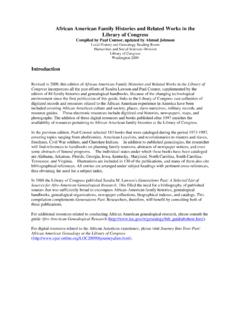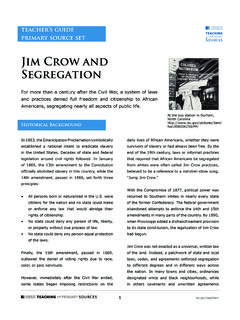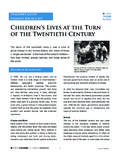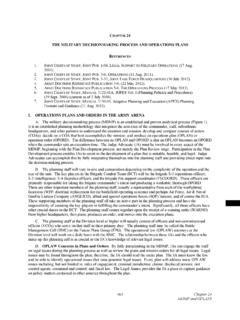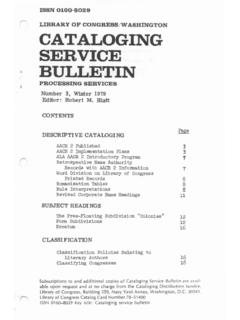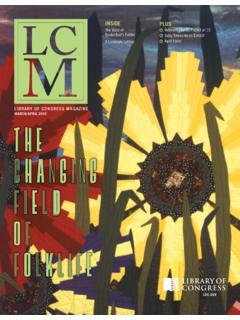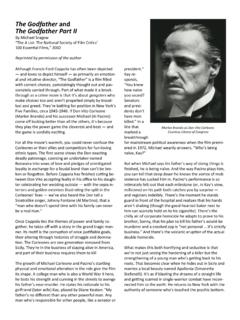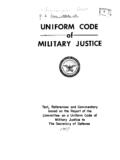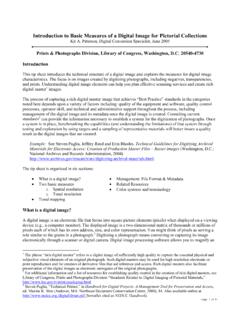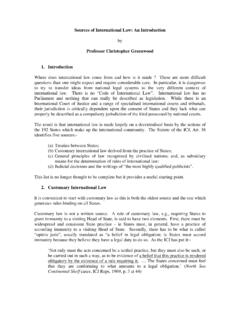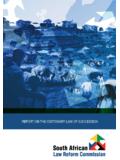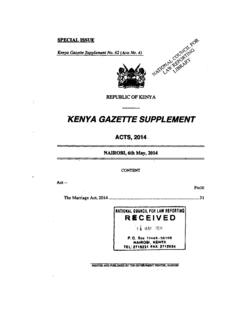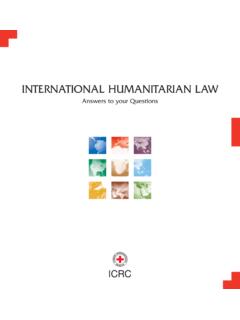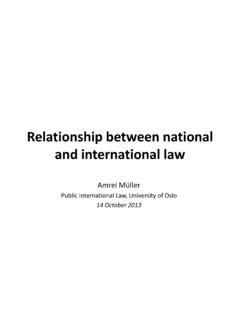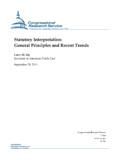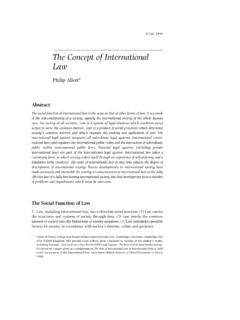Transcription of Law of Land Warfare - Home | Library of Congress
1 LAW OF LAND Warfare . J. A. G. S. TEXT NO. 7. The Judge Advocate General's School ANN ARBOR, MICHIGAN. LIST OF CURRENT TMTS. 0f THE JUDGE ADVOCATE GENEBAL'S SCHOOL. PPepared for instructional purposes only. JAGS TEXT No. 1 MILITARY JUSTICE. Procedural guide for staff Judge advocates. JAGS TEXT No. 2 MILITARY JUSTICE. Comments on common errors and irregularities in court-martial procedure. , JAGS TEXT No. 3 MILITARY AFFAIRS. Selected materials in the bibliography, proce- . dure and substantive law of military affairs. JAGS TEXT No. 4 WAR PObERS AND MILITARY JURISDICTION. Introduction to military jurisdiction and an orientation in the field of military law. JAGS TEXT No. 5 GOVERNMENT CONTRACTS. The principles and practice relating to go$-ern- ment contracts. *JAGS TEXT No. 6 CASEBOOK - GOVERNMENT CONTRACTS. A companion volume to JAGS TEXT No. 5 containing edited cases on government contracts. JAGS TEXT'No. 7 LAW OF LAND Warfare . Commentary on the rules of land Warfare .
2 JAGS TEXT No. 8 CLAIMS BY AND AGAINST THE GOVERNMENT. Principles, statutory provisions and procedure relating to Army tort claims. *JAGS TEXT No. 9 SELECTED OPINIONS - MILITARY AFFAIRS. Companion volume to JAGS TEXT No. 3, containing cur~entselected opinions of the Military Affairs Division, Office of The Jud%e Advocate General. JAGS TEXT No. 10 Publication discontinued. JAGS TEXT No. 11 LAW OF BELLIGERENT OCCUPATION. JAGS TEXT No. 12 GOVERNMENT CONTRACTS AND READJUSTMENT. Legal, procedural and fiscal principles involved in the termination of government contracts. *Available only to students while in attendance. This t e x t i s intended a s an a i d t o s t u d e n t s i n The Judge Ad- vocate General's School i n t h e study of t h e Rules of Land Warfare , F i e l d Manual 27-10. The arrangement a s w e l l a s t h e paragraph num . b e r s follow t h e F i e l d Manual. Fundamental p r i n c i p l e s r a t h e r than t h e more minute d e t a i l s a r e emphasized, although divergences of i n t e r p r e t a t i o n and p r a c t i c e a r e i n d i c a t e d.
3 Topics i n t h e F i e l d Manual r e q u i r i n g no a d d i t i o n a l discussion a r e omitted. The scope of t h e t e x t i s l i m i t e d t o t h e following t o p i c s : b a s i c p r i n c i p l e s of land Warfare , s t a t u s of persons i n war, t h e conduct of h o s t i l i t i e s , p r i s o n e r s of war, and t h e s i c k , wounded and dead. This t e x t was prepared i n t h e C i v i l A f f a i r s Department of The Judge Advocate General's School.. REGINALJI C MILLER, Colonel, J .A .G . D o , Commandant . The Judge Advocate General's School, United S t a t e s A r m y , Ann Arbor, Michigan, 1 September 1943, Reissued 1 J u l y 1945, C O N T E N T S..ooOo 0.. PART I. Chapter Page I . BASIC RULES AND PRINCIPLES. General .. Conventional Rules .. customary Rules .. Basic Principles .. Military Necessity .. Humanity .. Chivalry .. Force of R~lea.~.. Military Jurisdiction .. I1 . QUALIFICATIONS OF ARMED FORCE OF BELLIGERENTS.
4 General Division of Enemy Population .. Lawful Belligerents .. The Army .. Irre~lars .. Levee en Masse .. Combatants and Noncombatants .. Guerrillas .. HOSTILITIES. Commencement of Hostilities .. Treatment of Alien Enemies .. Means of Injur-ing the Enemy Limited .. Hague Declaration No . XIV of October 18, Poisons, Gases and Treachery and Assassination.,.,.,~O. Quarter ..;. 0 0 0 0. Employment of Arms, etc . , Causing Unnecessary Subjects Not to be Compelled to Take Part in Operations Against Their Own Country .. Chapter Page I11 .. HOSTILITIES (~ontd) .. Bombardments. Assaults. and 40. Assaults mdBombardments .. 40. Seizure and Destruction of Property During Operations; 43.. 46. Unanchored Submarine Mines .. 46. IV . PRISONERS OF WAR. Who May Become Prisoners of War .. Civilian Internees .. Civilians Following the Army .. Armed Forces .. Subjects of Neutral States .. Personal Safeguards Accorded Prisoners of War .. Reprisals Against Prisoners of Mar.
5 Persons and Honor to be R3~pected .. Duty of Maintenance .. Discrimination .. Must Give Name and Rank; Coercion to Obtain Military Information Prohibited .. Effects That May be Retained by Prisoners .. Evacuation; Notification of Capture .. Prisoners in Places of Danger .. Sick and Wounded .. Notification of Capture .. Internment .. Unhealthy Location .. Segregation of Nationalities .. Installation of Camps; Rations; Clothing .. Installation of Camps .. Rations .. Clothing .. Sanitation and Medical Care .. Sanitation .. Medical Care .. Religious Freedom .. Recreation .. Courtesy and Discipline .. Communication of Orders, etc .. iii . Chapter Page Pay and Maintenance of Officers and Assimiles .. 71. Assimiles .. 71. Officers Pay and Maintenance .. 72. Authorized and Prohibited Work of Prisoners of War .. 75. Officers and Assimiles .. 75. Other Prisoners of War .. 76. Unhealthful or Dangerous Work .. 78. Kind of Work Prohibited.
6 80. Wages of Prisoners of War and Deductions for Maintenance .. 83. Work Accidents .. 86. Correspondence and Parcels .. 87. Protecting Power and Complaints .. 90. Relief Societies .. 92. Official Information Bureau .. 93. Crimes and Offenses 94.. 94.. O O O O O . O .. General Disciplinary Punishment .. 96. Judicial Proceedings .. 100. Escape .. 102. C~ncurrentJurisdiction of Civil Courts over prisoners of war .. 106. Release of Prisoners .. 106. a d of war .. 106. Return of Sick and Wounded .. 109. Exchange .. 111. Military Service After Repatriation or Exchame .. o o ~ o ~112~ ~ ~ ~ b Parole .. 113. Death in Captivity .. 120. V . SICK. WOUNDED AND DEAD. General Rules .. 121. Treatment of Wounded and Dead .. 125. Ownership of Personal Effects .. 127. Sanitary Formations and Establishments .. 130. Personnel of Sanitary Formations and .. 134. Buildings and Materiel .. 138. Sanitary Transportation .. 142. Sanitary Aircraft .. 145.
7 The Distinctive Emblem of the Red Cross .. 149. LIST OF WORKS NOT REFERRED TO BY FULL TITLES. Air Power - Spaight, Air Power and War Rightg, 2nd ed. (1933). Am. J. Int. L. - The American Journal of International Law Baker and Crocker - The Laws of Land Warfare Concerning The Rights and Duties of Belligerents as Existing on August 1, 1914 (1918). Baty and Morgan - a : Its Conduct and Legal Results (1915). Bordwell - The Law of War Between Belligerents (1908). Brierly - The Law of Nations, 2nd ed. (1936). Davis - Davis, The Elements of International Law With an Account of its Origin, Sources . and Historical Development, 4th ed (1916), by Gordon E. Sherman Des Gouttes - La Convention De Geneve pour LfAmelioration DLI Sort Des Blesses et Des Malades Dans Les Armees En Campagne DU 27 Juillet 1929 (1930). Edmonds and Oppenheim - Land Warfare , A n Exposition of the Laws and Usages of War on Land for the Guidance of Officers of His Majesty's Army (1912).
8 Fenwick - International Law (1924). Flory - Prisoners of War, A Study in the Develop- ment of International Law (1942). Garner - International Law and the World War (1920). Grotius Society - The Transactions of the Grotius Society Hackworth - Digest of International Law (1940). Hall - Hall, A Treatise on International Law, 7th ed. (1917), by A. Pearce Higgins Holland - ~ h .Laws & of War on Land (1908). - Hyde - International-LawChiefly as Interpreted and Applied by the United States (1922). L a m ence - Lawrence, The Principles of International Law, 7th ed. (1923), by Percy . Lauterpacht - L. Oppenheim, International Law, A Treatfse, 6th ed. (1940), by H. Lauterpacht Moore - A Digest of ~nternationalLaw (1906). Phillipson - International Law and The Great War (1915). Raamussen - Code Des Prisonniers De Guerre, Commentaire De La Convention DU 27 Juillet 1929, Rel- ative au Traitment Des Prisonniers De Guerre (1931). Spaight - War Rights on Land (1911).
9 - United States, War Department, Office of the Chief of Staff. Rules , 1914, corrected to April 15, 1917, Wash- ington, Walker - Pitt Cobbett, Cases on International Law, 5th ed. (1937), by Wyndham Legh Walker We stlake - International Law (1907). Winf ield - The Foundations and the Future of Intey- national Law (1941). CHAPTER I. BASIC RULES AND PRINCTPLES. 1. laws of war are the rules respecting war- fare with which, according to international law, belligerents and neutrals are bound to comply.' The rules of land Warfare had their origin in the practices and usages of war which gradually grew into customs or were embodied in conventions .2 Thus, the existing law is comprised of two branches--the conventional law and the customary law. In either case, its authoritativeness ( , its character as law) arises from the consent of nations. Express consent is given by 'treaties or conventions, tacit consent by habitual obseryance of certain rules (custom) between In dealing with customary law, two difficulties may present themselves in any given case-he difficulty of proving the par- ticular custom and the difficulty in determining whether a par- ticular practice has developed into a custom ( , has it been 1.)
10 Edmonds and Oppenheim, par. I-. 2. The term "conventional" law is used to indicate those rules that have been embodied in treaties or conventions as dis- tinguished from cus$omary internstimal law, i . ~ . , the unwritten rules. 3. Lawrence, p , 95. See, however, Brierly, p. 40, where it is stated: "Implied consent is not a philosophically sound explanation of customary law, international or municipal; a customary rule is observed, not because it has been consented to, but because it is believed to be binding * , * *". approved by the comon consent of civilized nations). Whether a particular usage has been agreed to is a matter of evidence. 4. The test for determining whether a usage has become an obligatory custom is that it must be approved by the common consent of civil- ized nations .5 All need hot necessarily consent to create cus- tomary law if the practice be accepted generally. The dissent or assent of some states may be more authoritative than that of other states.
